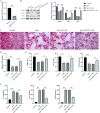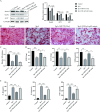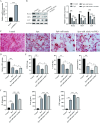METTL3 accelerates staphylococcal protein A (SpA)-induced osteomyelitis progression by regulating m6A methylation-modified miR-320a
- PMID: 39506767
- PMCID: PMC11542406
- DOI: 10.1186/s13018-024-05164-2
METTL3 accelerates staphylococcal protein A (SpA)-induced osteomyelitis progression by regulating m6A methylation-modified miR-320a
Abstract
Osteomyelitis (OM) is an inflammatory disease of bone infection and destruction characterized by dysregulation of bone homeostasis. Staphylococcus aureus (SA) has been reported to be the most common pathogen causing infectious OM. Recent studies have demonstrated that N6-methyladenosine (m6A) regulators are associated with the development of OM. However, the molecular mechanism of m6A modifications in OM remains unclear. Here, we investigated the function of methyltransferase-like 3 (METTL3)-mediated m6A modification in OM development. In this study, human bone mesenchymal stem cells (hBMSCs) were treated with staphylococcal protein A (SpA), a vital virulence factor of SA, to construct cell models of OM. Firstly, we found that METTL3 was upregulated in OM patients and SpA-induced hBMSCs, and SpA treatment suppressed osteogenic differentiation and induced oxidative stress and inflammatory injury in hBMSCs. Functional experiments showed that METTL3 knockdown alleviated the inhibition of osteogenic differentiation and the promotion of oxidative stress and inflammation in SpA-treated hBMSCs. Furthermore, METTL3-mediated m6A modification upregulated miR-320a expression by promoting pri-miR-320a maturation, and the mitigating effects of METTL3 knockdown on SpA-mediated osteogenic differentiation, oxidative stress and inflammatory responses can be reversed by miR-320 mimic. In addition, we demonstrated that phosphatidylinositol-4, 5-bisphosphate 3-kinase catalytic subunit alpha (PIK3CA) was a downstream target of miR-320a, upregulation of PIK3CA alleviated miR-320a-induced inhibition of osteogenic differentiation, and upregulation of oxidative stress and inflammatory responses during SpA infection. Finally, we found that silencing METTL3 alleviated OM development by regulating the miR-320a/PIK3CA axis. Taken together, our data demonstrated that the METTL3/m6A/miR-320a/PIK3CA axis regulated SpA-mediated osteogenic differentiation, oxidative stress, and inflammatory responses in OM, which may provide a new therapeutic strategy for OM patients.
Keywords: staphylococcus aureus; Inflammatory response; Osteogenic differentiation; Osteomyelitis; Oxidative stress.
© 2024. The Author(s).
Conflict of interest statement
The authors declare no competing interests.
Figures







Similar articles
-
Long non-coding RNA KCNQ1OT1 overexpression promotes osteogenic differentiation of staphylococcus aureus-infected human bone mesenchymal stem cells by sponging microRNA miR-29b-3p.Bioengineered. 2022 Mar;13(3):5855-5867. doi: 10.1080/21655979.2022.2037898. Bioengineered. 2022. PMID: 35226820 Free PMC article.
-
METTL3-mediated LINC00657 promotes osteogenic differentiation of mesenchymal stem cells via miR-144-3p/BMPR1B axis.Cell Tissue Res. 2022 May;388(2):301-312. doi: 10.1007/s00441-022-03588-y. Epub 2022 Feb 22. Cell Tissue Res. 2022. PMID: 35192037
-
piRNA-36741 regulates BMP2-mediated osteoblast differentiation via METTL3 controlled m6A modification.Aging (Albany NY). 2021 Oct 13;13(19):23361-23375. doi: 10.18632/aging.203630. Epub 2021 Oct 13. Aging (Albany NY). 2021. PMID: 34645714 Free PMC article.
-
KCNQ1OT1 regulates osteogenic differentiation of hBMSC by miR-320a/Smad5 axis.Eur Rev Med Pharmacol Sci. 2020 Mar;24(6):2843-2854. doi: 10.26355/eurrev_202003_20648. Eur Rev Med Pharmacol Sci. 2020. PMID: 32271402
-
METTL3-mediated m6A RNA methylation induces the differentiation of lung resident mesenchymal stem cells into myofibroblasts via the miR-21/PTEN pathway.Respir Res. 2023 Nov 28;24(1):300. doi: 10.1186/s12931-023-02606-z. Respir Res. 2023. PMID: 38017523 Free PMC article. Review.
References
-
- Ma X, Xia W, Zong Y, Jiang C, Shan H, Lin Y, et al. Tumor necrosis factor-α promotes Staphylococcus aureus-induced osteomyelitis through downregulating endothelial nitric oxide synthase. J Microbiol Immunol Infect. 2021;54(6):1018–27. 10.1016/j.jmii.2020.08.002. - PubMed
MeSH terms
Substances
Grants and funding
- 202102AA310068/Yunnan Orthopedics and Sports Rehabilitation Clinical Medicine Research Center
- 202102AA310068/Yunnan Orthopedics and Sports Rehabilitation Clinical Medicine Research Center
- ZX20191001/Yunnan Provincial Clinical Orthopaedic Trauma Medical Center
- ZX20191001/Yunnan Provincial Clinical Orthopaedic Trauma Medical Center
- 202101AY070001-294/Applied Basic Research Joint Project of Yunnan Science and Technology Department and Kunming Medical University
LinkOut - more resources
Full Text Sources
Miscellaneous

